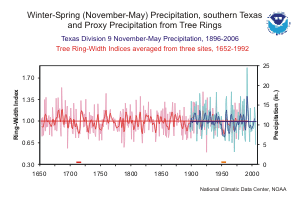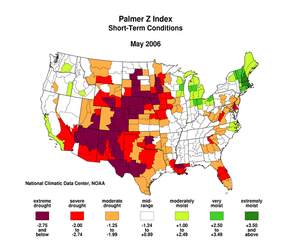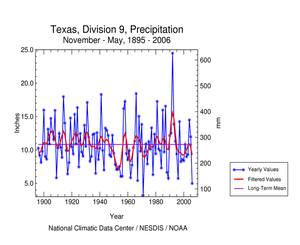U.S. Drought Highlights:
-
On the national scale:
- Severe to extreme drought affected about 20 percent of the contiguous United States as of the end of May 2006.
- Moderate to extreme drought affected about 39 percent of the contiguous U.S.
- Dryness was observed in May over much of the country. The Southwest, western Texas, western High Plains and the south Atlantic states have experienced very dry conditions for the last several months. The most severe conditions in May were in the Desert Southwest to the northern Plains, and the Big Bend region of Texas. About 11 percent of the contiguous U.S. was very dry (i.e., precipitation in the bottom 10th percentile of the historical record).
- Coupled with the very dry conditions were high temperatures in the Southwest and Plains. The combination of high temperatures and very little precipitation led to extreme drought as defined by the Palmer Z Index.
- Dryness persisted in the mid-Atlantic States and southern Appalachians, central Florida and along the Louisiana coast. Evaporation in these areas was high, and streamflow was low.
- The wheat harvest in Oklahoma is expected to be the worst in 50 years due to drought, wildfires, high winds, hail storms, insects and frost damage (AP, 5/22). On May 9, the USDA authorized a federal drought disaster declaration in all but one of the counties in Arizona.
Please Note: The data presented in this drought report are preliminary. Ranks, anomalies, and percent areas may change as more complete data are received and processed.
National Overview
On the national scale,
- severe to extreme drought affected about 20 percent of the contiguous United States as of the end of May 2006, an increase of about 7 percent compared to last month
- about 39 percent of the contiguous U.S. fell in the moderate to extreme drought categories (based on the Palmer Drought Index) at the end of May
- on a broad scale, the previous two decades (1980s and 1990s) were characterized by unusual wetness with short periods of extensive droughts, whereas the 1930s and 1950s were characterized by prolonged periods of extensive droughts with little wetness
- about 9 percent of the contiguous U.S. fell in the severely to extremely wet categories at the end of May
- a file containing the national monthly percent area severely dry and wet from 1900 to present is available
- historical temperature, precipitation, and Palmer drought data from 1895 to present for climate divisions, states, and regions in the contiguous U.S. are available at the Climate Division: Temperature-Precipitation-Drought Data page in files having names that start with "drd964x" and ending with "txt" (without the quotes).
Regional Overview
Dryness was observed in May over much of the country. The Southwest, western Texas, western High Plains and the south Atlantic states have experienced very dry conditions for the last several months. The most severe conditions in May were in the Desert Southwest to the northern Plains, and the Big Bend region of Texas. About 11 percent of the contiguous U.S. was very dry (i.e., precipitation in the bottom 10th percentile of the historical record).
Coupled with the very dry conditions were high temperatures in the Southwest and Plains. The combination of high temperatures and very little precipitation led to extreme drought as defined by the Palmer Z Index.
Dryness persisted in the mid-Atlantic States and southern Appalachians, central Florida and along the Louisiana coast. Evaporation in these areas was high, and streamflow was low.
The May precipitation pattern at the primary stations in Alaska was below normal throughout most of the state. However, the southeastern coastal region was wetter than normal. Across Hawaii, the precipitation pattern was wet in the Southeast and progressively drier towards the Northwest. In Puerto Rico, the month was predominantly dry in the east and wet along the northwest coast, based on National Weather Service radar estimates of precipitation.
The wheat harvest in Oklahoma is expected to be the worst in 50 years due to drought, wildfires, high winds, hail storms, insects and frost damage (AP, 5/22). On May 9, the USDA authorized a federal drought disaster declaration in all but one of the counties in Arizona.
Some regional highlights:
- Several states had the tenth driest, or drier, multi-month seasons (March-May, December-May, June-May.
- Month-averaged and end-of-month soil moisture conditions, based on model computations (CPC-1, CPC-2, MRCC), were drier than normal across a broad swath from the Southwest and central Plains to the Atlantic coast. The models also indicated dry soil moisture conditions in parts of Alaska, and improved soil moisture conditions near the surface and at depth across most of the Midwest except eastern Nebraska and Kansas.
- May streamflows were below seasonal norms across much of the East, and parts of the central Plains, as computed by models and based on USGS observations.
- Drought conditions in the Southwest continued during May. About 24 percent of the western U.S. (Rockies westward) fell in the moderate to extreme drought category (as defined by the Palmer Drought Index) as of the end of May. Snow water content at the end of the month reflected the dry conditions in most of the West.
Paleoclimatic Perspectives
May 2006, Pre-Instrumental Perspective, Southern Texas
Near-average rainfall occurred in far southern Texas in May, but it wasn't nearly enough to relieve severe drought conditions exacerbated by rainfall far below average during the previous five months. Since November 2005, precipitation in Texas Division 9 has been only 48% of average (based on 1950-2000), and 59% of average since June 2005. Even after the May 2006 rains, most of Division 9 (Southern Texas) was classified as being in "exceptional drought" (D4) on the late May to early June U.S. Drought Monitor.
The graph below (annual values in light blue, 5-year weighted average in dark blue) shows the winter-spring (November-May) precipitation, 1896-2006, for Texas Division 9. The value for 2006 (4.98") is the 2nd lowest since 1896, after 1971 (3.16"). The most striking multi-year anomaly in this record is the 1950s drought (indicated with orange bar), which had seven consecutive years (1950-1956) with below-average winter-spring precipitation.

Paleoclimatic tree-ring reconstruction and observed
precipitation for Texas Division 9 for
the total period 1652-2006 - 200 KB Image
The graph to the left also shows a 341-year tree-ring record (1652-1992; annual values in light red; 5-year smoothed values in dark red) that corresponds well to the variability in November-May precipitation. This record is the average of three tree-ring chronologies (Douglas-fir, post oak, and Montezuma bald cypress) from Texas and northern Mexico. The correlation between the annual values of the tree-ring record and November-May precipitation is 0.686, indicating a high degree of shared variance. The tree-ring record captures the multi-year variability of the observed precipitation record particularly well.
The tree-ring record, as a proxy for precipitation, can put the winter precipitation variability of the last century in southern Texas into a much longer perspective. The record shows a number of individual years in the approximately 250 years prior to 1895 that may have had very low winter-spring precipitation similar to the lowest values in the past century. Among multi-year droughts, the 1950s appears unusually persistent and severe even in the context of the entire tree-ring record. Prior to 1950, the ring-width index was below average for seven years in a row only once (1711-1717; red bar), and the total cumulative ring-width anomaly for that period was not as great as for 1950-1956, suggesting it was not quite as severe as the 1950s drought.
Resources:
- Divisional climate data, including precipitation for Texas Division 9 as shown above, can be obtained from NCDC.
- Tree-ring data, including the chronologies for Big Bend (Texas), South Texas Composite (Texas), and Rio Sabinas (Mexico), can be obtained from the International Tree-Ring Data Bank (ITRDB), World Data Center for Paleoclimatology.
References:
- Big Bend (Texas):
- Cook, E. R., Meko, D. M., Stahle, D. W., and Cleaveland, M. K., 1999. "Drought reconstructions for the continental United States." Journal of Climate 12: 1145-1162.
- South Texas Composite (Texas):
- Therrell, M. D., 2000. "The historic and paleoclimatic significance of log buildings in South-central Texas." Historical Archaeology 34: 25-37.
- Rio Sabinas (Mexico):
- Therrell, M. D., Stahle, D. W., Cleaveland, M. K., and Villanueva-Diaz, J., 2002. "Warm Season Tree Growth and Precipitation over Mexico." Journal of Geophysical Research 107 (D14), 10.1029/2001JD000851.
 NOAA's National Centers for Environmental Information
NOAA's National Centers for Environmental Information


